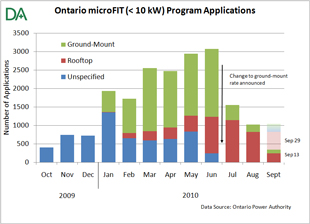We received our first glimpse last week on the impact of the 20% rate reduction in Ontario’s Solar PV microFIT (<10 kW) program.
The speakers at last week’s Ontario Feed-In-Tariff (FIT) Supply Chain Forum provided extensive new information on the FIT program status. Among other insights, Jim MacDougall from the Ontario Power Authority (OPA) presented a chart that provided a month-by-month tally of incoming applications for the microFIT program.

Drop in FIT Rate Sharply Reduces Demand
This chart outlined the striking effect the July 2 surprise rate change notice had on incoming microFIT applications.
microFIT Applications Drop
According to the numbers provided by MacDougall, microFIT applications halved from June to July, and dropped again in August. These declines have been led by a dramatically reduced number of ground-mount applications. Ground-mount microFIT applications dropped by over 75% from June to July, and then halved again in August.
Surprisingly, the number of rooftop applications also declined in August even though the microFIT rooftop tariff rates are unchanged.
In conjunction with the August 13 rate cut for ground-mount projects, the OPA also restricted what it terms Commercial Aggregators from participating in the FIT program. Given their facilitation role, it is probable that restricting the involvement of these Aggregators is responsible for the decline in rooftop applications. Without Commercial Aggregators, the microFIT program is less accessible to Ontario residents.
The current rate of microFIT applications – roughly 1,000 per month – will support an annual volume of less than 120 MW per year. That demand volume is equal to about one-tenth of the module manufacturing capacity that manufacturers have committed thus far to meet Ontario Domestic Content Requirements and serve the Ontario market.
Domestic Content Requirements Increase Ahead of Schedule
Meanwhile, last Friday the OPA also announced that all new applications must now meet the 2011 levels for Domestic Content of 60%.
While many companies have announced of new factories to cater to the Ontario program’s Domestic Content requirements, few of these factories are in full operation. Given the time required for these factories to come on line, there has been increasing concern over product shortages next year.
According to the OPA’s Bi-Weekly FIT and microFIT Report, there is now a backlog of roughly 10,000 microFIT applications awaiting installation along with another roughly 9,000 applications awaiting approval. Altogether, this represents 181 MW of backlog that can help provide initial demand for the new factories and the jobs they create.
Due to Transmission capacity constraints on the Ontario grid, the microFIT program and small commercial rooftop projects under the FIT program will represent the bulk of the solar PV installations going forward. Unless something is done to reverse the microFIT demand drop, it may not be long before overcapacity becomes a concern for the new Ontario solar industry.




No Responses to “Rate Drop Reduces Ontario Solar FIT Applications”
Trackbacks/Pingbacks